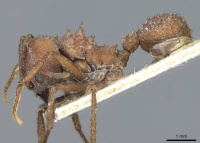Acromyrmex pulvereus
| Acromyrmex pulvereus | |
|---|---|

| |
| Scientific classification | |
| Kingdom: | Animalia |
| Phylum: | Arthropoda |
| Class: | Insecta |
| Order: | Hymenoptera |
| Family: | Formicidae |
| Subfamily: | Myrmicinae |
| Tribe: | Attini |
| Genus: | Acromyrmex |
| Species: | A. pulvereus |
| Binomial name | |
| Acromyrmex pulvereus Santschi, 1919 | |
Identification
Distribution
Distribution based on Regional Taxon Lists
Neotropical Region: Argentina (type locality).
Distribution based on AntMaps
Distribution based on AntWeb specimens
Check data from AntWeb
Countries Occupied
| Number of countries occupied by this species based on AntWiki Regional Taxon Lists. In general, fewer countries occupied indicates a narrower range, while more countries indicates a more widespread species. |

|
Estimated Abundance
| Relative abundance based on number of AntMaps records per species (this species within the purple bar). Fewer records (to the left) indicates a less abundant/encountered species while more records (to the right) indicates more abundant/encountered species. |

|
Biology
|
Castes
Nomenclature
The following information is derived from Barry Bolton's Online Catalogue of the Ants of the World.
- pulvereus. Acromyrmex (Moellerius) pulvereus Santschi, 1919f: 52 (w.) ARGENTINA (Córdoba).
- Type-material: syntype workers (number not stated).
- Type-localities: Argentina: Córdoba, Unquillo (M. Birabén) (invalid restriction of type-locality by Kempf, 1972a: 16; no lectotype designated), Argentina: Córdoba, Cabana (M. Birabén).
- Type-depository: NHMB.
- [Note: Fowler, 1988: 289, and Brandão, 1991: 324, cite pulvereus as a nomen dubium.]
- Status as species: Santschi, 1925a: 388 (in key); Kempf, 1972a: 16; Fowler, 1988: 289; Cherrett & Cherrett, 1989: 51; Bolton, 1995b: 56.
- Distribution: Argentina.
Description
References
- Bolton, B. 1995b. A new general catalogue of the ants of the world. Cambridge, Mass.: Harvard University Press, 504 pp. (page 56, catalogue)
- Fowler, H. G. 1988b. Taxa of the neotropical grass-cutting ants, Acromyrmex (Hymenoptera: Formicidae: Attini). Científica (Jaboticabal) 16: 281-295 (page 289, see also)
- Santschi, F. 1919f. Nouveaux formicides de la République Argentine. An. Soc. Cient. Argent. 87: 37-57 (page 52, worker described)
References based on Global Ant Biodiversity Informatics
- Cuezzo, F. 1998. Formicidae. Chapter 42 in Morrone J.J., and S. Coscaron (dirs) Biodiversidad de artropodos argentinos: una perspectiva biotaxonomica Ediciones Sur, La Plata. Pages 452-462.

